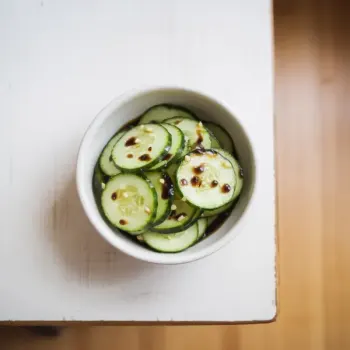
 45 minutes
45 minutesEmbrace the natural sweetness and hearty texture of kabocha squash in this soul-warming side dish. The Japanese pumpkin is enhanced with the subtle sweetness of coconut palm sugar, a whisper of cinnamon, and the creamy embrace of oat milk. This velvety mash is perfect as a comforting side dish or a unique breakfast option, offering a twist on traditional morning flavors.


Kabocha Squash, quartered
0 lb
tablespoons
Coconut Palm Sugar
teaspoons
teaspoons
Unsweetened Oat Milk, warmed
cups
Flaky Sea Salt
to taste
1. Oven Preparation
Preheat the oven to 375°F (190°C).
2. Prep the Squash
Clean the squash by removing the seeds and strings—reserve the seeds for another recipe. Place the squash quarters cut-side up on a rimmed baking sheet. Pour water into the sheet until it reaches ¼ inch in depth.
3. Roast the Squash
Cover the squash with aluminum foil and roast in the preheated oven until tender, approximately 35 minutes. Check tenderness with a fork.
4. Scoop and Compost
Remove the squash from the oven. Carefully scoop out the flesh and place it into a medium mixing bowl. Dispose of the skins in your compost.
5. Mash and Season
Using a fork, mash the squash until it starts to become smooth. Mix in the coconut oil, coconut palm sugar, and cinnamon for a fragrant touch.
6. Creamy Finish
Gradually pour the warmed oat milk into the squash mixture, stirring continuously with the fork until you achieve a creamy, smooth consistency.
7. Serve with a Pinch
Finish by sprinkling the mash with flaky sea salt to taste, then serve warm and enjoy the comforting flavors.
Instead of boiling the squash, try roasting it to concentrate its flavor. You can also roast it with some garlic cloves for an extra layer of taste.
Instead of cinnamon, try using cardamom or a pinch of nutmeg for a different kind of warmth. You can also add a bit of ground ginger or a spice mix like pumpkin pie spice for complexity.
Swap out the sweetener you might typically use with a drizzle of maple syrup over the finished mash for a deep, autumnal sweetness.
Caramelize some onions and mix them into the mash to add a savory note that complements the squash's natural sweetness.
Incorporate texture by topping the mash with toasted pecans, walnuts, or slivered almonds. You could also stir in some roasted pepitas (pumpkin seeds) for a nut-free crunch.
Look for a kabocha squash that feels heavy for its size, which indicates it's ripe and will be sweeter and more flavorful. Smaller kabochas tend to be sweeter.
To intensify the flavor, consider roasting the kabocha squash instead of boiling it. Roasting caramelizes the natural sugars in the squash, adding depth to the flavor profile.
A pinch of salt is crucial to balance the natural sweetness of the squash and coconut. A squeeze of fresh lime juice after mashing can add brightness to the dish.
For a smoother mash, use a food processor or immersion blender. For a more rustic texture, a hand masher will do. Avoid over-mashing to prevent a gluey texture.
Use full-fat coconut milk for the creamiest texture and richest flavor. Toasting some shredded coconut as a garnish can add extra coconut complexity.




Comments (0)